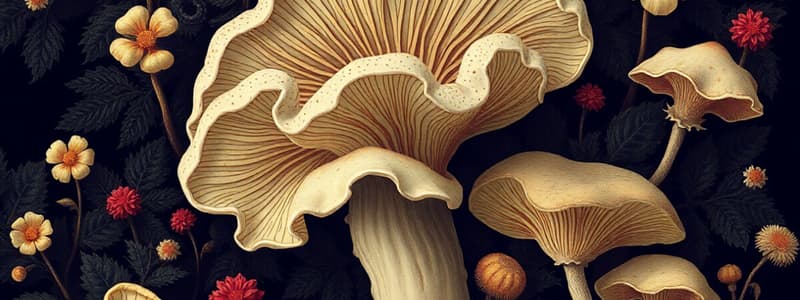Podcast
Questions and Answers
Which type of fungi is characterized by the formation of zygospores during sexual reproduction?
Which type of fungi is characterized by the formation of zygospores during sexual reproduction?
- Ascomycetes
- Basidiomycetes
- Zygomycetes (correct)
- Deuteromycetes
What characterizes hyphae in fungi?
What characterizes hyphae in fungi?
- They are short branched cellular structures.
- They primarily serve as reproductive organs.
- They are unicellular organisms.
- They are long branching cellular structures. (correct)
Which of the following statements is true regarding the thermal dimorphism of fungi?
Which of the following statements is true regarding the thermal dimorphism of fungi?
- Yeasts grow at room temperature.
- Molds grow at room temperature while yeasts grow at 37 degrees Celsius. (correct)
- Molds and yeasts both grow at room temperature.
- Molds grow optimally at 37 degrees Celsius.
Which fungal species is classified as a budding yeast?
Which fungal species is classified as a budding yeast?
What type of spores do Ascomycetes produce during sexual reproduction?
What type of spores do Ascomycetes produce during sexual reproduction?
Which of the following fungi primarily utilizes opportunistic infections?
Which of the following fungi primarily utilizes opportunistic infections?
What is the primary function of mycelium in fungi?
What is the primary function of mycelium in fungi?
Flashcards
Fungi: Heterotrophs
Fungi: Heterotrophs
Fungi are organisms that cannot make their own food and need organic carbon from other sources.
Fungi: Cell wall composition
Fungi: Cell wall composition
Fungi have cell walls made of chitin.
Fungi: Hyphae
Fungi: Hyphae
Fungi have long, branching structures called hyphae that grow along surfaces.
Fungi: Types
Fungi: Types
Signup and view all the flashcards
Thermal Dimorphism in Fungi
Thermal Dimorphism in Fungi
Signup and view all the flashcards
Fungi Reproduction (Asexual)
Fungi Reproduction (Asexual)
Signup and view all the flashcards
Fungi Reproduction (Sexual)
Fungi Reproduction (Sexual)
Signup and view all the flashcards
Study Notes
Fungi General Characteristics
- Fungi are heterotrophs, meaning they require organic carbon.
- They are saprotrophs, decomposing dead organic matter.
- Fungi form symbiotic relationships with other species, such as algae and bacteria.
- Fungi serve as food sources and play a role in food production for humans and other organisms.
- Fungi have cell walls made of chitin.
- Fungi can be multicellular (e.g., molds) or unicellular (e.g., yeast).
- Fungi have hyphae, long, branching, cellular structures.
- Hyphae can form a network called a mycelium.
- Vegetative hyphae grow along the substrate.
- Reproductive hyphae extend upwards and produce spores.
- Fungi exhibit thermal dimorphism: molds grow at room temperature, while yeast grows at 37°C.
- Some fungi are opportunistic pathogens, infecting weakened or immunocompromised individuals.
Types of Fungi
Zygomycetes
- Zygomycetes produce zygospores during sexual reproduction and sporangiospores during asexual reproduction.
- Rhizopus stolonifer is an example of a zygomycete, producing both zygospores and sporangiospores.
Ascomycetes
- Ascomycetes form ascospores during sexual reproduction and conidiospores during asexual reproduction.
- Penicillium notatum and Aspergillus niger are examples of ascomycetes, producing conidiospores.
Basidiomycetes
- Basidiomycetes produce basidiospores during sexual reproduction.
- They generally lack well-defined asexual reproduction.
Yeast
- Saccharomyces cerevisiae (budding yeast) is a type of yeast.
Studying That Suits You
Use AI to generate personalized quizzes and flashcards to suit your learning preferences.




